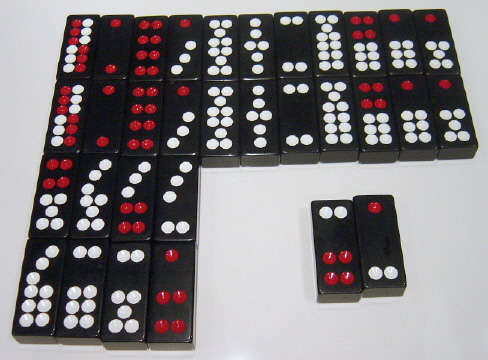Pai Gow Poker is a card game that first appeared in California in the 1980s; a blend of both eastern and western traditional gambling games that made for a fast-paced, high-action casino game. Today it is considered one of the biggest moneymaking card games for the casino industry across the world.
An Introduction to Pai Gow Poker
Pai Gow, also known as two-handed poker. Also, this remains as a casino game that involves elements of poker, Chinese Pai Gow, and other games. The game uses a standard 52-card poker deck plus one joker, which is either wild or semi-wild.
Players start by receiving seven cards in the pai gow poker game. Then, which they use to make two separate poker hands – one two-card hand and one five-card hand. The players do not play against each other, but rather each player is going against the dealer or “house.”
If both of the player’s hands beat both of the house’s hands, then the player is paid out. Then, both of the dealer’s hands beat both of the player’s hands. Also, the casino wins and takes the player’s money.
So, if the player wins one hand, the dealer wins the other than this is considered a “push” and the player takes their initial bet back. In the case of a tie, the house is declared the winner.
The Pai Gow Poker Rankings

The two-card hand is called the “front” hand, and the five-card hand is the “back” hand. The front hand is not allowed to be better than the backhand in pai gow poker. Also, with the hand rankings following standard poker hand rankings.
Just like any customized deck of cards game and uno game cards, there exists various rankings. Going from the lowest possible hand to the highest possible, these are:
- High card (worst)
- One pair
- Two pair
- Three of a kind
- Straight (five cards of consecutive value)
- Flush (five cards of the same suit)
- Full house (one pair plus three of a kind)
- Four of a kind
- Straight flush (five cards consecutively of the same suit) (best)
The End Game
In general, the house takes no commission from a push hand and takes a 5% commission from winning hands, though this can vary per casino. This means that if you bet $100 and you win, the payout is $95.
If played correctly, Pai Gow Poker can have one of the smallest house edges of any casino game. In general, the house advantage is measured at about 2.5%. Specifically, below the averages of roulette (5.3%), slot machines (5%-10%).
Also, it includes other table games like Caribbean stud (5.2%), let it ride (3.5%), and three card poker (3.4%). Its odds remain commonly beaten only by craps (.6-1.5%), blackjack (2%), Baccarat (1.2%) and video poker (.5%-3%).
A History of Pai Gow Poker

Pai Gow Poker is one of the newer card games in the casino world. However, its principles borrow liberally from a combination of two of the oldest games known to humans: poker and Chinese Pai Gow.
While its exact origins are unknown, poker dates back at least 500 years. Pai Gow, on the other hand, is even older. Pai Gow Poker at least dates back to the Song dynasty (960-1279), if not earlier.
It implied an originally played game using domino-like tiles and a complicated set of rules designed to mimic the Chinese social hierarchies of the time. Pai Gow means “make nine,” which is essentially the structure of the ancient game.
Particularly, as the object is for players to group their tiles into sets of nine. It is possible that poker may also have some of its roots in Chinese tile games.
However, this link is not as well documented as its connections to the Persian card game of “As-Nas,” which originated in the 1600s. As-Nas uses a unique set of cards that features five suits of five cards each: an ace and four “court” cards.
The Pai Gow Poker in the History
Players then attempt to make combinations of these cards such as pairs, three of a kind, or a full house (a pair plus a three of a kind). Poker gets its name from the French game Poque, whose rules even more closely match those of the modern game.
Poque is itself a derivation of the German game pochen, which in turn comes from several renaissance-era gambling games like primero, brelan, and brag. While many of these games have different structures, a set of rules began needs standards.
This includes the adaptation of the classic 52-card deck, the standardization of hand rankings. Most, importantly the element of bluffing. Many people do not consider Pai Gow Poker to be a proper form of poker.
Because it does not give the player the ability to bluff. Then, making it in many ways more akin to gambling games like blackjack.
The Beginnings of its Development
In 1985, the two games blended into Pai Gow Poker by a man named Sam Torosian. Torosian owned the Bell card club in Los Angeles. Even more, at the time the gambling options remain limited.
Due to outdated state amended laws, the only gambling allowed in the area where the card games draw poker, lowball, and panguingue. Torosian’s business was slow, and he was looking for ways to rekindle interest in his casinos.
Accordingly, Torosian began casting about for new ideas when an elderly Filipino player told him about a game that he’d seen in China called puy soy. Specifically, this involved the players making and playing multiple different hands.
Torosian and Pai Gow Poker
Primarily, Torosian adapted and simplified this structure. This cuts the action down to two hands that the player would play against the dealer’s two hands. As soon as Torosian started dealing Pai Gow Poker in his card room, it was a hit.
His casino filled up and other owners soon followed his lead, quickly adding Pai Gow tables to their gambling floors. Las Vegas casinos began playing it in 1987, and Atlantic City added Pai Gow the following year.
Ironically, Pai Gow Poker has now migrated back east and has become popular in casinos in China, Macau, and the other regions where Pai Gow was first invented.
The Modern Pai Gow Poker Game

Unfortunately for Torosian, he missed the opportunity to patent the game and profit off of his innovation. He received some legal advice that made him believe the game was unpatentable.
And, by the time he figured out that this was incorrect his window of opportunity for filing the patent had passed. Today Pai Gow is one of the most profitable casino games in the world.
It is hard to say exactly how much Torosian would have made on the game had he been able to claim credit for it.
The Availability
However, popular estimates are that he would have made about $70,000 a month, or almost $30 million total. Other estimates go even higher, claiming that his patent could have been worth hundreds of millions of dollars.
Torosian eventually closed the Bell card room and retired comfortably but not as comfortably as he could have. The most recent evolution of the game has come in the form of online Pai Gow Poker, which is available from many online casinos.
Online Pai Gow Poker introduced the concept of the bonus bet, which pays out based on their best seven card hand, as well as the “house way” option that allows the players to have their hands automatically sorted for them.
Pai Gow Poker – Rules, Tips, and Strategies

The rules of Pai Gow are quite simple. Players start by placing a bet in front of them into the betting area. Different tables will have different upper and lower betting limits.
Consequently, with the lowest amounts potentially as low as a dollar a hand and the highest amounts reaching into the millions. Just like the war card game, as well as the spider card and golf card games, secret strategies help you win.
The Strategies
All players and the dealer receive seven total cards and make the best five card and two card poker hands, with the front hand not having a value higher than the backhand.
This means that if a player had one pair and five unmatching cards. Then, the pair would have to go into their backhand. Now, their front hand would most likely contain their highest unmatched card.
If players don’t follow this rule, then typically both hands come as ‘dead’, and their ‘forfeited’ hands. After players have set their hands, placing them in the designated areas on the table felt, the dealer reveals their hand.
The dealer then pays out or collects from each player in turn.
The Take
A losing bet remains forfeited entirely, and a winning bet comes as paid out 1:1. The exception to this is the house rake, which tends to be about 5% of the bet. Also, all ties go to the dealer, further increasing the house’s edge.
One way that players can shift the odds back to their favor is by banking whenever this option is available. When a player acts as banker, they become the de facto house.
The banker plays against all the other players at the table, pays out their winnings, and collects their losses. In this case, all ties go to the player and the player is not subject to the same rake as when the house is the banker.
This role can rotate between the house and whichever players declare an interest though not every casino will allow it. Ultimately, banking implies not typically an option found in online Pai Gow Poker rooms.
Conclusion
Pai Gow Poker may be new, however, it has firmly established its place in the gaming landscape. It has made millions of dollars for players and casinos alike. Although, it didn’t make nearly as much money as it should have for one man.
Thus, Mr. Sam Torosian, the person that actually invented it. Head out to your nearest casino or jump online and you too can take part in Mr. Torosian’s legacy. But, always remember to do so responsibly.


I want to learn paigow poker